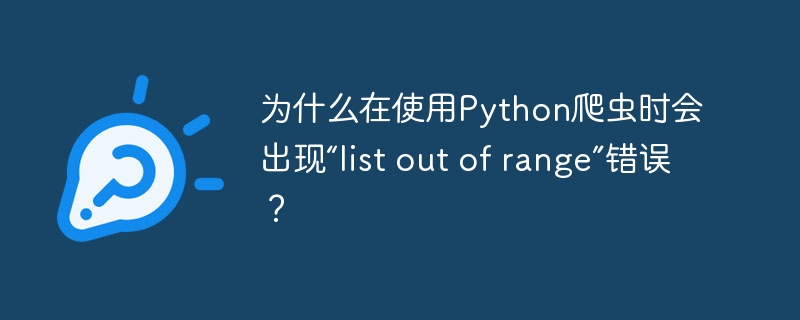在使用Python爬虫时,如果你遇到了“listoutofrange”错误,这通常意味着你试图访问一个列表中的索引,但这个索引超出了列表的范围。以下是一些常见的原因和解决方法:索引错误:原因:你可能在尝试访问一个列表的元素时,使用了一个不存在的索引。例如,如果列表只有5个元素,但你试图访问第6个元素(索引为5),就会出现这个错误。解决方法:确保你使用的索引在列表的有效范围内。你可以使用len()函
时间:2025-04-03 22:54:47 458浏览 收藏
Python爬虫程序中经常会遇到`list index out of range`错误,这通常是因为访问了列表索引范围之外的元素。本文分析了该错误的几种常见原因,包括索引错误、动态修改列表、数据源变化和循环索引问题,并提供了相应的解决方法。主要策略包括使用`len()`函数检查列表长度,在访问元素前进行边界检查,在修改列表时重新计算索引,添加异常处理和日志记录以及仔细检查循环条件。通过这些方法,可以有效避免此错误,提升爬虫程序的健壮性和可靠性。

Python爬虫中的“list index out of range”错误:原因及解决方法
在使用Python和BeautifulSoup进行网页爬取时,经常会遇到list index out of range错误。即使代码没有修改,也可能出现这种问题,尤其是在处理动态网页或网站结构变化时。本文将分析此错误的原因,并提供有效的解决方案。
以下是一个示例代码,它演示了可能导致该错误出现的情况:
import requests
from bs4 import BeautifulSoup
headers = {'user-agent': 'Mozilla/5.0 (Windows NT 10.0; Win64; x64) AppleWebKit/537.36 (KHTML, like Gecko) Chrome/124.0.0.0 Safari/537.36 Edg/124.0.0.0'}
response = requests.get("https://www.iqiyi.com/ranks1/3/0", headers=headers)
print(response.status_code)
response = response.text
soup = BeautifulSoup(response, "html.parser")
def extract_data():
titles = [title.get_text().strip() for title in soup.find_all("div", class_="rvi__tit1")]
heat = [heat.get_text().strip() for heat in soup.find_all("span", class_="rvi__index__num")]
introductions = [intro.get_text().strip() for intro in soup.find_all("p", class_="rvi__des2")]
return titles, heat, introductions
def display_data(titles, heat, introductions):
min_len = min(len(titles), len(heat), len(introductions))
for i in range(min_len):
print(f"排名: {i+1}, 标题: {titles[i]}, 热度: {heat[i]}, 简介: {introductions[i]}")
if __name__ == '__main__':
titles, heat, introductions = extract_data()
display_data(titles, heat, introductions)
在这个例子中,list index out of range错误通常发生在display_data函数中。原因是:titles,heat,introductions这三个列表的长度可能不一致。如果其中一个列表的长度小于10(或者循环的范围),那么在访问列表元素时就会出现索引越界错误。
解决方法:
关键在于确保在访问列表元素之前,检查列表的长度,并只访问有效索引范围内的元素。 改进后的代码如下:
import requests
from bs4 import BeautifulSoup
# ... (headers and request remain the same) ...
def extract_data():
# ... (extraction remains the same) ...
def display_data(titles, heat, introductions):
min_len = min(len(titles), len(heat), len(introductions)) # Find the shortest list
for i in range(min_len):
print(f"排名: {i+1}, 标题: {titles[i]}, 热度: {heat[i]}, 简介: {introductions[i]}")
if __name__ == '__main__':
titles, heat, introductions = extract_data()
display_data(titles, heat, introductions)
通过计算三个列表中最短的长度 min_len,并使用 min_len 作为循环的范围,我们确保了不会访问到任何超出列表索引范围的元素,从而有效地避免了list index out of range错误。 这是一种更健壮的处理方式,能够适应不同网页结构和数据数量的变化。 此外,添加错误处理机制(例如try-except块)也是一种好的编程实践,可以处理更复杂的情况。
以上就是本文的全部内容了,是否有顺利帮助你解决问题?若是能给你带来学习上的帮助,请大家多多支持golang学习网!更多关于文章的相关知识,也可关注golang学习网公众号。
-
501 收藏
-
501 收藏
-
501 收藏
-
501 收藏
-
501 收藏
-
476 收藏
-
311 收藏
-
272 收藏
-
401 收藏
-
372 收藏
-
222 收藏
-
442 收藏
-
351 收藏
-
453 收藏
-
363 收藏
-
110 收藏
-
391 收藏
-

- 前端进阶之JavaScript设计模式
- 设计模式是开发人员在软件开发过程中面临一般问题时的解决方案,代表了最佳的实践。本课程的主打内容包括JS常见设计模式以及具体应用场景,打造一站式知识长龙服务,适合有JS基础的同学学习。
- 立即学习 543次学习
-

- GO语言核心编程课程
- 本课程采用真实案例,全面具体可落地,从理论到实践,一步一步将GO核心编程技术、编程思想、底层实现融会贯通,使学习者贴近时代脉搏,做IT互联网时代的弄潮儿。
- 立即学习 516次学习
-

- 简单聊聊mysql8与网络通信
- 如有问题加微信:Le-studyg;在课程中,我们将首先介绍MySQL8的新特性,包括性能优化、安全增强、新数据类型等,帮助学生快速熟悉MySQL8的最新功能。接着,我们将深入解析MySQL的网络通信机制,包括协议、连接管理、数据传输等,让
- 立即学习 500次学习
-

- JavaScript正则表达式基础与实战
- 在任何一门编程语言中,正则表达式,都是一项重要的知识,它提供了高效的字符串匹配与捕获机制,可以极大的简化程序设计。
- 立即学习 487次学习
-

- 从零制作响应式网站—Grid布局
- 本系列教程将展示从零制作一个假想的网络科技公司官网,分为导航,轮播,关于我们,成功案例,服务流程,团队介绍,数据部分,公司动态,底部信息等内容区块。网站整体采用CSSGrid布局,支持响应式,有流畅过渡和展现动画。
- 立即学习 485次学习
